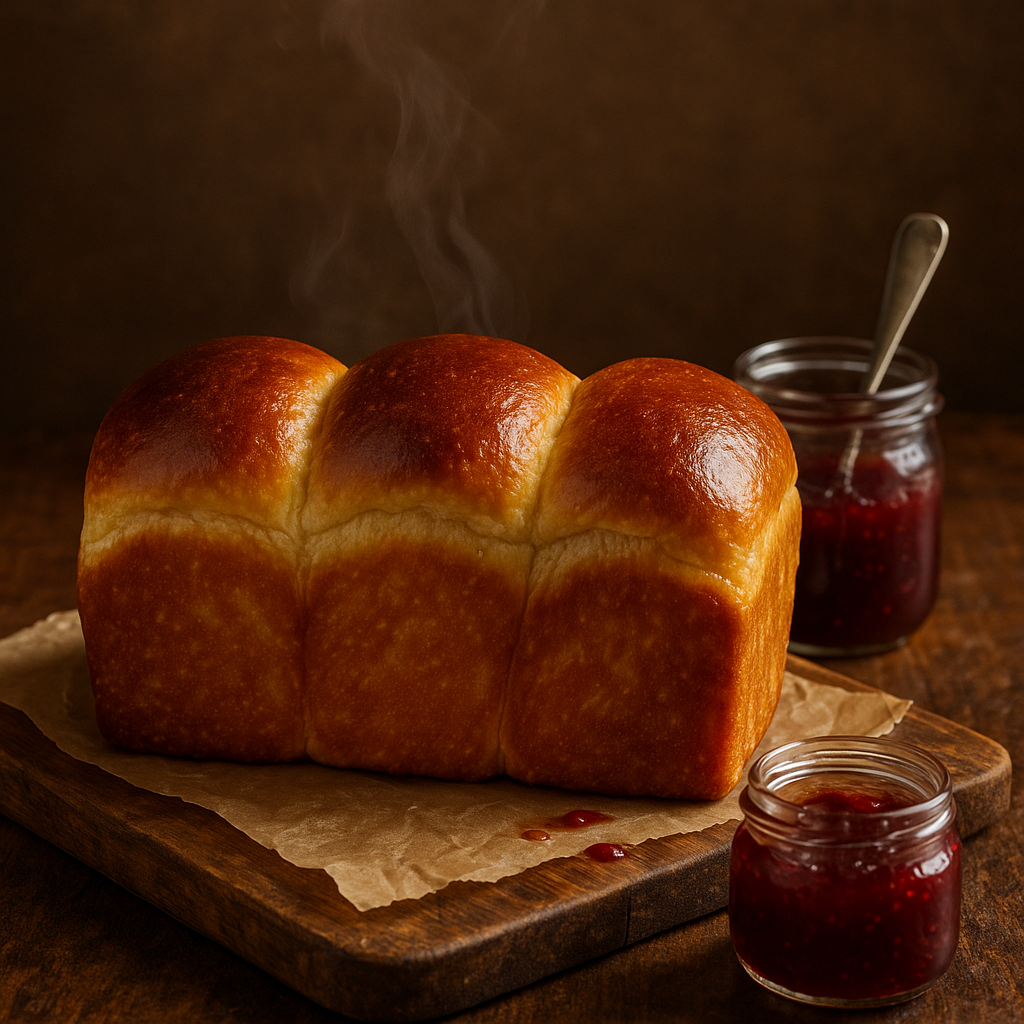Soft Milk Bread (Fluffy, Pillowy, and Homemade)
A Loaf to Tear Into Warm

This soft milk bread is everything you want in a homemade loaf: tender, slightly sweet, and melt-in-your-mouth fluffy. Enriched with milk, egg, and butter, it’s golden on the outside, cloud-soft on the inside — perfect for toasting, sandwiches, or tearing warm straight from the oven. With simple ingredients and a little time, you’ll get bakery-quality results right from your kitchen.
Pillow-Soft Bread, Fresh from the Oven
This fluffy homemade bread is enriched with milk, egg, and butter for a tender crumb and golden crust. Lightly sweet and perfectly soft, it's ideal for toasting, snacking, or pulling apart fresh from the oven. No fancy tools or techniques — just simple steps and bakery-worthy results.
Ingredients:
- 320–340g bread flour (start with 320g, add more as needed while kneading)
- 160g milk (room temperature or slightly warm)
- 1 egg
- 5g instant yeast
- 5g salt
- 5–25g sugar (5g for neutral flavor, 25g for sweeter bread)
- 30g unsalted butter, softened
- Optional egg wash: 1 egg yolk + 1 tbsp milk, mixed
Instructions:
1. Mix dry ingredients:
In the bowl of a stand mixer, combine bread flour, sugar, salt, and instant yeast. Mix briefly to evenly distribute.
2. Add milk and egg:
Pour in the milk and egg, then mix on low speed with a dough hook until the mixture forms a rough dough.
3. Add butter and knead:
Once the dough comes together, add the softened butter. Knead on medium speed for 10–15 minutes, until the dough becomes smooth, stretchy, and slightly tacky. Add a little more flour if it's too sticky. You should be able to stretch the dough thin without tearing — this is the windowpane test.
4. First rise:
Shape the dough into a ball and place it in a lightly greased bowl. Cover and let rise in a warm place for about 1 hour, or until doubled in size. If the dough springs back slowly when poked, it's ready.
5. Divide and rest:
Turn the dough out onto a clean surface and divide it into 3 equal portions. Shape each into a loose ball and let them rest for 10–15 minutes, uncovered, to relax the gluten.
6. Shape the dough:
Roll each piece into an oval using a rolling pin. Then roll it up from the short end like a jelly roll. Pinch the seams closed and place the rolls seam-side down into a greased loaf pan side by side.
7. Second rise:
Cover loosely and let the dough rise again for about 1 hour, or until puffy and nearly doubled.
8. Preheat and apply egg wash:
Preheat your oven to 340°F (170°C). Mix the egg yolk and milk, then gently brush the top of the dough for a shiny finish.
9. Bake:
Bake for 25–30 minutes, or until the top is golden brown and the loaf sounds hollow when tapped.
10. Cool and serve:
Let the loaf rest in the pan for 5 minutes, then transfer to a wire rack to cool completely. Slice or tear to serve — best enjoyed fresh or lightly toasted.
Why Metric?
For clarity and consistency, I use metric measurements in my recipes. It's more accurate (especially for baking), easier to scale up or down, and ensures better results — no guessing whether your "cup" is packed or level. But don’t worry, US equivalents are included below so you can bake with whatever you have on hand.
| Ingredient | Metric | US Equivalent |
|---|---|---|
| Bread flour | 320–340 g | 2½ to 2¾ cups (start with 320 g) |
| Milk (room temp or warm) | 160 g | ⅔ cup |
| Egg | 1 large | 1 large |
| Instant yeast | 5 g | 1½ tsp |
| Salt | 5 g | 1 tsp |
| Sugar | 5–25 g | 1 tsp to 2 tbsp (to taste) |
| Unsalted butter (softened) | 30 g | 2 tbsp |
| Egg wash (optional) | — | 1 egg yolk + 1 tbsp milk |
Storage:
- Room Temperature: Store the cooled loaf in an airtight bag or container at room temperature for up to 3 days. Avoid refrigerating — it dries out the bread faster.
- Freezer: Wrap slices or the whole loaf tightly in plastic wrap and freeze in a freezer bag for up to 1 month. Thaw at room temp and reheat gently before serving.
- To Refresh: Toast slices or warm slightly in the oven for that just-baked softness again.
Notes:
- Flour Adjustment: Start with 320g flour. Add a little more during kneading if the dough feels too sticky, but keep it on the softer side for a tender crumb.
- Milk Type: Whole milk gives the best flavor and softness, but low-fat or plant-based milk can be used.
- Butter Matters: Use room temperature butter so it kneads in smoothly — cold butter will tear the dough.
- Sweetness Level: Use 5g sugar for a neutral sandwich loaf, or up to 25g for a lightly sweet, milk bread flavor.
- Egg Wash Tip: For a shiny, golden finish, don't skip the egg wash. You can also brush with milk only for a softer matte look.
This post contains affiliate links. As an Amazon Associate, I earn from qualifying purchases.
Thank you for being here as I start this journey. I can’t wait to share more recipes, tips, and stories with you — one crumb at a time.
Stay tuned,
~ Clever Crumbs
